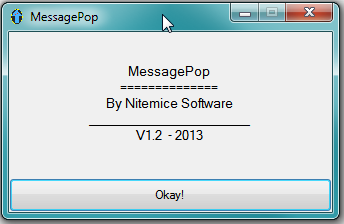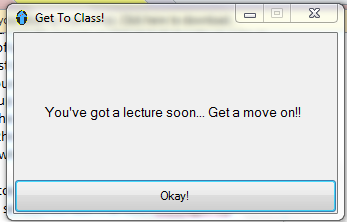
MessagePop
MessagePop is a small, Windows program that can be used to display a message, set via command line arguments, in an always-on-top popup window. For Windows Vista and up.

If you want to read the backstory that lead me to create MessagePop, I wrote a blog post about it a while back.
So the basics of how to use MessagePop are:
- You run the program however you want, with the message as a command line parameter.
- You can also set the title text and the button text by simply putting a hash
#with a space on both side, and then the next bit of text. So to specify all three, it should look something like this:
This is my message. # Titles are cool! # Press the button!
- You can skip entering a message or title text if you want by hashing past it, e.g. if you don't want to specify a title, but you do want to specify the button text, write your message, and then adding
space hash space hash space(# #) and then type what you want the button to say. - You can quickly close MessagePop by hitting either the Enter or Escape keys.
MessagePop can be used in various ways. It can be run on a schedule like an alarm, from command line as a warning or alert prompt, or from a shortcut for some reason. If you've got an idea for how to use MessagePop, go ahead! And tell me, because I'd love to know!
Download
You can download it from:
And if you like it, you might be interested in:
- Checking out the source code on GitHub
- Voting it up on alternativeTo
Version History
1.2.5 (19/9/2013) : Made adjustments for upload to GitHub & added licence
1.2 (25/5/2013) : Added ability to skip specifying message and/or title
1.1 (16/5/2013) : Initial release build
1.0 (8/5/2013) : Initial concept build
MessagePop is provided under a MIT Licence, which can be found in the readme.

How to use MessagePop as a scheduled notification
- Open Task Scheduler by simply typing it into the start-search bar, or however you like...
- On the right hand side, you will see a list of Actions. Choose Create Basic Task...

- Type in a meaningful title and description so that you'll know what it is when you go looking around in here some other time.
WARNING! You cannot change the name of your task, so make it a good one to start off with.

- On the next screen, set how often you want the task to fire. In my case, I want it weekly, at a specific time, each day (which I'll set in the next step). Then hit Next.
- If you're setting up something like I am, on the next screen, you'll be able to set on what days at what time you want the task to trigger. If you have different times depending on the days, like me, I'll explain how to set that up later.
- On the next screen, choose Start A Program. Then hit Next.
- Here's where you need to choose MessagePop. Click on the Browse... button and navigate to where you've saved it, and then hit OK.

- Before you click Next, you need to enter the message you want to appear in MessagePop when it runs, by entering it into the Add Arguments: box. Like discussed above, you should enter the message first, followed by any title text and button text, each separated by a hash (
#). - On the next screen, you get a chance to check that everything you entered is correct, but it doesn't matter too much because you can go back later and change just about anything (except the title).
- If you want to adjust your times, or you want to add more than one trigger tick Open the Properties dialog, before hitting Finish.
- In the Properties dialog, you can adjust lots of things, like anything we just set up, as well as lots of other stuff like only running on AC power (which I don't want on- it's in the conditions tab).

- The main thing we want to do here is edit the time that the task triggers at. I want to add a different time on a Wednesday, so I go to the Triggers tab, click on New, near the bottom, and put in the details as necessary.

- You can also change your MessagePop message by going to the Actions tab, and clicking on Edit, next to New, to bring up a window where you can change the program arguments.

- If you want to test what it looks like when the action is triggered, you can by selecting it in the main panel of Task Scheduler, and clicking Run in the bottom half of the right sidebar. You may need to click on Task Scheduler Library in the left sidebar to get the tasks to appear. Don't be surprised if you got tonnes of tasks that you never knew about!!

